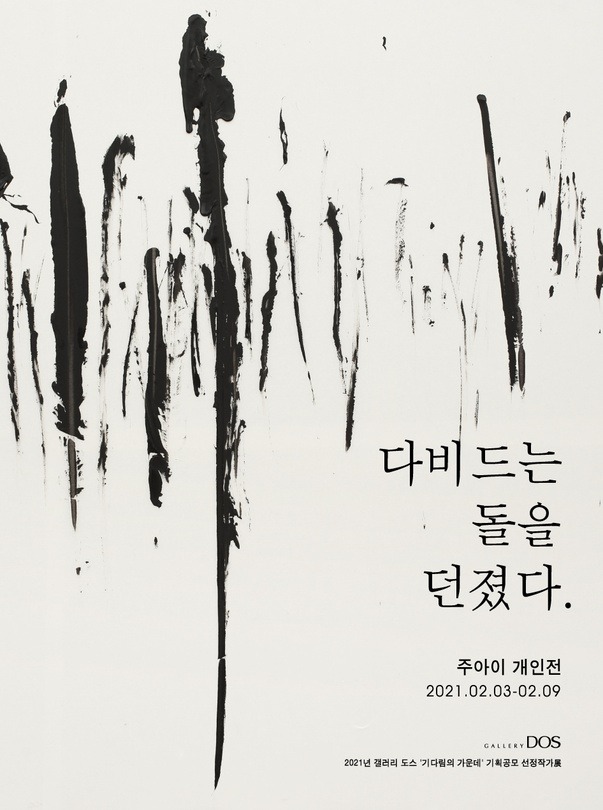
| Period| | 2021.02.03 - 2021.02.09 |
|---|---|
| Operating hours| | Mon - Sun 11:00 ~ 18:00 |
| Space| | Gallery Dos/Seoul |
| Address| | 37, Samcheong-ro 7-gil, Jongno-gu, Seoul, Republic of Korea |
| Closed| | the Lunar New Year and Chuseok holidays |
| Price| | Free |
| Phone| | 02-737-4678 |
| Web site| | 홈페이지 바로가기 |
| Artist| |
주아이
|
정보수정요청



|
|
Exhibition Information
We exist and live with other people in society. The acceleration of modern material affluence and growth has brought convenience, but there is always a hidden sense of anxiety about existence. The author expresses human history by leaving only the pure image of a line on the screen. One line is like living life and gives it a personality. Since ancient times, it has been believed that in the East, ink, and ink can be expressed depending on how it is handled, and the Joo tries to approach the existence of human beings by interpreting it in a modern way. In the variation shown by Ilpil Hwiji's trivial and ordinary lines, coexistence and confrontation are harmonized, which does not only stay on the screen but penetrates into space where we stand now. Several lines appear repeated and overlapped in the work. Good is a constant inspiration to the Joo and is the most implicit expression of the human world experienced by culture or individual tendencies. As it is said that a single stroke is the basis of ten thousand shapes, omission, connotation, and metaphor are characteristics of ink painting. It is said that there is a tremendous possibility of expressing inner things by displaying such an invisible and high-level spirit. It is said that there is an infinite possibility of expressing inner things by displaying such an invisible and high-level spirit. In the work, the good symbolizes human beings, but it is not limited to attitudes toward a particular object but shows a holistic perception of the surrounding world. The expression of the lines shown by the author is a combination of accidental effects with improvisation and some calculated effects. It will make a new attempt based on various material tests to bring out a changed and deep screen by utilizing the smudges of ink and the characteristics of the oriental painting. In particular, the intentional method of directing, which allows the audience to stay in front of the screen by tilting the screen to the wall or by setting the two screens at right angles, shows that the space in the work can be expanded to the outside. The screen is filled with only simple and still static. It seems like a space where there is nothing, but just as the Joo visits something from nothing, the Joo seriously intertwines questions about humans. Lines are placed very concisely in empty spaces, and this pure margin allows us to focus more on the nature of the features in the work. Repeated lines on the screen show overlapping and continuous features, where no center exists and there is no clear distinction between foreground and background, shape and background. These characteristics also make the screen look like a simple pattern with pure flatness. The screen, which is composed using the interaction of the direction, thickness, and spacing of lines, is placed on the boundary between the artist's main will and coincidence at that time. Joo freely expands Joo's thoughts and expressions without constraints in an ambiguous space without any distinction or boundaries and unfolds her work activities. Based on the social interrelationships of modern society created by oneself and others, Joo intends to solve his/her philosophical ideas and take a step further with his/her own self. It expresses a human being in symbolic shape by comparing it to a line and embodies the energy generated within it, showing the full power inherent in a seemingly ordinary object. The expression in art reflects an active attitude to understand the world in which you live. The reason for how to look at and understand the current world, which includes the artist's own existence, naturally leads to the search for manipulation. Just as the expression of the mind eventually results in the matter, the essential expression of ink-and-wash is itself an expression, while expressing the philosophy that humans themselves have seen and felt about the providence of nature with food and brushes. Just as Oriental philosophy emphasized the harmony of all things, the work is completed only when even the audience standing in front of an indeterminate figure coexists with a single subjective consciousness.
